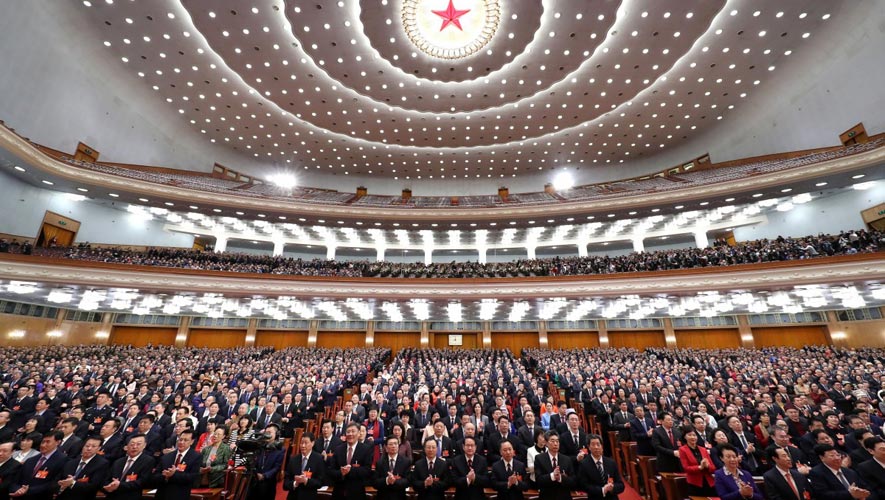China and the United States are expected to come to an agreement soon over trade frictions, analysts said, as the negotiating teams are reported to be discussing the wording of an accord and considering applying the brakes to their tariff standoff.
For the latest Cambodian Business news, visit Khmer Times Business
They made the prediction after Chinese and US officials said there had been concrete progress on multiple issues in the latest round of trade talks in Washington.
During the latest talks, held from Thursday to Sunday in Washington, the seventh round since February of last year, the two sides focused on the text of an agreement, the Chinese delegation said, according to a Xinhua News Agency report.
The negotiators also had made substantial progress on such specific issues as technology transfers, protection of intellectual property rights, nontariff barriers, the service industry, agriculture and exchange rates, the delegation said.
On the basis of the latest progress, the two sides are expected to continue their work into the next stage, in accordance with the instructions of the two countries’ top leaders, according to Xinhua.
State Councilor Wang Yi said Sino-US trade negotiations have once again made concrete progress and provided positive prospects for bilateral relations and the global economy. Wang, also minister of foreign affairs, made the remark at an event on Monday, according to a statement issued by the ministry.
Yao Yang, dean of the National School of Development at Peking University, said, “It is encouraging that both sides have begun to work on the text of an agreement, which indicates a speeding up toward sealing a trade deal.”
“The progress also showed that effective economic diplomatic measures can help resolve cumbersome issues and reduce confrontation between two nations,” Yao said.
After tit-for-tat exchanges of hefty import tariffs, President Xi Jinping and his US counterpart, Donald Trump, agreed in December to halt new tariffs for 90 days to allow for talks. Since then, negotiations have been conducted on a wide array of topics.
Early Sunday afternoon in Washington, Trump tweeted that he “will be delaying” the increase of tariffs on Chinese imports scheduled for March 1, due to “very productive” trade talks between the two countries.
Chen Bin, executive vice-president of the China Machinery Industry Federation, said the organization’s member companies are optimistic because the extension of the March 1 tariff deadline should help both Chinese and US companies restore their ability to trade, while pacifying Chinese companies that have already invested heavily in machinery manufacturing in the US.
“It is increasingly evident that tariffs had negative effects — such as rising unemployment and slowing growth rates — not only in China and the US, but also in many parts of the world,” said Xue Rongjiu, deputy director of the Beijing-based China Society for WTO Studies research institute.
The proposed tariff delay indicates economic rationality is prevailing and both countries are predicted to reach an agreement soon, Xue added.
Asa Hutchinson, governor of the US state of Arkansas, applauded both presidents for working hard to narrow the differences and reach more consensuses. “I am optimistic we will be able to reach an agreement because it is important for both countries,” he said.
Given the complex nature of the economic and trade differences between China and the United States, no one should underestimate how difficult the challenge is to find compromises that satisfy their respective interests. Despite the optimism expressed by both sides that a deal can be reached, there is still some uncertainty about what that might actually entail.
This has created a situation in which relations between the two countries seem to be in a state of limbo similar to that of Schrödinger’s unfortunate cat as it waits for someone to look in the box.
If the US president had sneaked a peak before the weekend, he didn’t reveal it by tweeting — perhaps, perhaps not, was all he said on Friday when assessing the likelihood of a deal.
However, on Sunday, he presented a far more positive prognosis when he announced a stay of execution on the additional tariffs due to kick in if no agreement was reached by March 1, saying the talks on the weekend had been “very productive”.
This holds the promise that the two sides are finally close to reaching an agreement. Especially, as there have been hints that texts on various issues are being drafted.
A comprehensive agreement would be the most desirable way to put an end to the dispute and that now appears to be on the cards. After the progress that has been made in this round of negotiations, there is growing confidence on both sides that there is little chance of it all ending in tears and bitter acrimony.
That will certainly be true if before discussing the differences that present the greatest difficulties, their talks first mastered the more elementary issue of why such discussions were taking place at all.
Which is not as Washington claims, China’s misbehavior. But rather the belief in Washington that its investment in a future in which China would be a fully-paid up member of the US-led system has not paid off.
If, instead of feeling aggrieved, Washington has accepted that China will continue to adhere to its own system and the development path it has chosen, that will help ensure the lasting viability of a deal, that would clearly be in their own interests and those of the world.
China’s leadership has made it clear on a number of occasions that it is committed to further improving the efficiency, transparency and openness of the Chinese economy. But the US should bear in mind it cannot simply ignore the challenges created by any adjustments.
The talks are now at the most difficult stage, given the current momentum and substantial progress that have been made, if the two sides remain rational about what can and can’t be done, any challenges ahead can be overcome and the opportunities of greater trust and cooperation seized. (China Daily)




